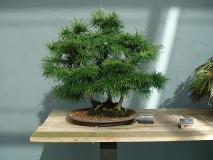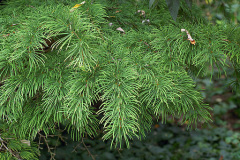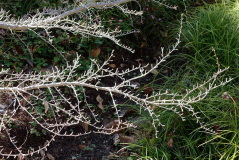- Home
- >
- Conifer Seeds P-Z by Latin Name
- >
- Chinese Golden Larch (pseudolarix amabilis)
Chinese Golden Larch (pseudolarix amabilis)
SKU:
£1.35
1.35
12.75
£1.35 - £12.75
Unavailable
per item
Seed Prices
1 gram (approx 25 seeds) £1.35
2 grams (approx 50 seeds) £1.95
5 grams (approx 125 seeds) £2.95
10 grams (approx 250 seeds) £5.50
25 grams (approx 625 seeds) £12.75
Use the drop down button to select the seed quantity
Photo Credits
Foliage -Eric Hunt (Own work (own photo)) [GFDL (http://www.gnu.org/copyleft/fdl.html), CC-BY-SA-3.0 (http://creativecommons.org/licenses/by-sa/3.0/) or CC BY 2.5 (http://creativecommons.org/licenses/by/2.5)], via Wikimedia Commons
Bonsai -Jeffrey O. Gustafson (Own work) [GFDL (http://www.gnu.org/copyleft/fdl.html) or CC BY-SA 3.0 (http://creativecommons.org/licenses/by-sa/3.0)], via Wikimedia Commons
Bare branches -Daderot - Own work, CC0, https://commons.wikimedia.org/w/index.php?curid=37424112
Foliage -Eric Hunt (Own work (own photo)) [GFDL (http://www.gnu.org/copyleft/fdl.html), CC-BY-SA-3.0 (http://creativecommons.org/licenses/by-sa/3.0/) or CC BY 2.5 (http://creativecommons.org/licenses/by/2.5)], via Wikimedia Commons
Bonsai -Jeffrey O. Gustafson (Own work) [GFDL (http://www.gnu.org/copyleft/fdl.html) or CC BY-SA 3.0 (http://creativecommons.org/licenses/by-sa/3.0)], via Wikimedia Commons
Bare branches -Daderot - Own work, CC0, https://commons.wikimedia.org/w/index.php?curid=37424112
The Chinese Golden Larch is a very attractive deciduous ornamental conifer which is suitable for parks and large gardens and bonsai cultivation.
It is not a true larch Larix species) but is more closely related to the true firs (abies species) and the cedars (cedrus). It is native to eastern China and unlike the true larches, is very tolerant of summer heat and humidity and grows very successfully in hot areas such as the southeastern United States where most larches and firs do not succeed.
In Europe growth is most successful around the Mediterranean region with the most notable specimens being found in northern Italy.In the United Kingdom it will grow more slowly due to the cooler summers to a maximum height of up to 18m (60ft)
The green summer foliage turns pale in early Autumn turning bright yellow in late October and November.
The Chinese Golden Larch is a very attractive deciduous ornamental conifer which is suitable for parks and large gardens and bonsai cultivation.
It is not a true larch Larix species) but is more closely related to the true firs (abies species) and the cedars (cedrus). It is native to eastern China and unlike the true larches, is very tolerant of summer heat and humidity and grows very successfully in hot areas such as the southeastern United States where most larches and firs do not succeed.
In Europe growth is most successful around the Mediterranean region with the most notable specimens being found in northern Italy.In the United Kingdom it will grow more slowly due to the cooler summers to a maximum height of up to 18m (60ft)
The green summer foliage turns pale in early Autumn turning bright yellow in late October and November.
Germination, Sowing and After Care Information for
Chinese Golden Larch (pseudolarix amabilis)
Chinese Golden Larch seeds are relatively easy to germinate and grow. The dormancy within the seed is fairly short and easily broken. This is achieved by a short period of cold stratification in the fridge.
You can do this by first soaking the seeds in water for 24 hours. Fully drain away all of the water and place the seeds in a zip-lock freezer bag. Place the seeds in the fridge, it is important that during this period that the seeds do not dry out or are waterlogged otherwise the pre-treatment will be ineffective.
After 8 weeks under these conditions the seeds are ready to be sown. In general, the seeds will fail to germinate unless treated in this way, simply sowing untreated seeds in compost at room temperature will not break down the dormancy and germination will be disappointing.
Fill your chosen container with a good quality general potting compost. Suitable containers could be plant pots, seed trays or plug trays or even improvised containers with drainage holes. Firm the compost gently and sow the seeds on the surface. If you are sowing in plug trays, sow 2 or 3 seeds per cell. Cover the seeds with a couple of millimeters of vermiculite or failing that a fine layer of sieved compost. Follow with a gentle watering and keep them at room temperature.
Germination will begin a few weeks from sowing. The seedlings are reasonably robust and trouble free and usually grow to a height of between 2 and 5 cm in the first growing season depending on the sowing date and cultural techniques. Densely sown seedlings are at risk from fungal diseases such as “damping off” which can cause rapid loss of many seedlings.
Developing seedlings should be fine in full sun, keep them well watered and free of competing weeds. Growth will accelerate in the second and subsequent years and the developing young trees should be re-potted as necessary preferably during the dormant season. After perhaps 3 years they are ready to be planted in their permanent position






